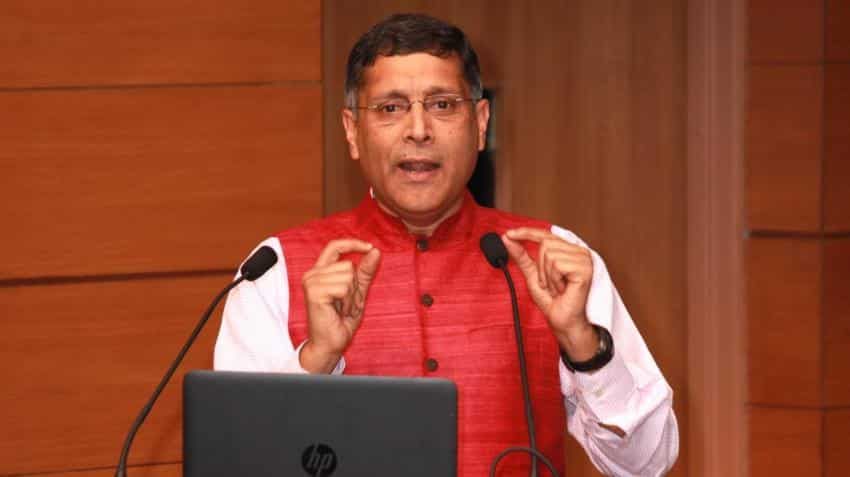GDP growth for FY18 projected at 6.75-7.5% post demonetisation: Economic Survey 2017
The cash squeeze in the meantime will have significant implications for GDP, reducing 2016-17 growth by ¼ to ½ percentage points compared to the baseline of 7%, the Economic Survey said.

The government has projected the real GDP growth in 2017-18 is projected to be in the range of 6.75-7.5%. The Economic Survey 2017 presented in Parliament on Tuesday by the union Finance Minister, Arun Jaitley states that once the cash supply is replenished, which is likely to be achieved by end March 2017, the economy would revert to the normal.
The government further says that the adverse impact of demonetisation on GDP growth will be transitional.
The Economic Survey points out that demonetisation will have both short-term costs and long-term benefits as detailed in the attached table. Briefly, the costs include a contraction in cash money supply and subsequent, albeit temporary, slowdown in GDP growth; and benefits include increased digitalisation, greater tax compliance and a reduction in real estate prices, which could increase long-run tax revenue collections and GDP growth.
On the benefits side, early evidence suggests that digitalisation has increased since demonetisation. On the cost side, effective cash in circulation fell sharply although by much less than commonly believed – a peak of 35% in December, rather than 62% in November since many of the old high denomination notes continued to be used for transactions in the weeks after 8November 8. Additionally, remonetisation will ensure that the cash squeeze is eliminated by April 2017.
“The cash squeeze in the meantime will have significant implications for GDP, reducing 2016-17 growth by ¼ to ½ percentage points compared to the baseline of 7%. Recorded GDP will understate impact on informal sector because, for example, informal manufacturing is estimated using formal sector indicators (Index of Industrial Production). These contractionary effects will dissipate by year-end when currency in circulation should once again be in line with estimated demand, which would also allow growth to converge to a trend by FY 2017-18,” the statement read.
The Economic Survey states that the weighted average price of real estate in eight major cities which was already on a declining trend fell further after November 8, 2016 with the announcement of demonetisation. It goes on to add that an equilibrium reduction in real estate prices is desirable as it will lead to affordable housing for the middle class and facilitate labour mobility across India currently impeded by high and unaffordable rents.
The Survey suggests a few measures to maximize long-term benefits and minimize short-term costs. One, fast remonetisation and especially, free convertibility of cash to deposits including through early elimination of withdrawal limits. This would reduce the GDP growth deceleration and cash hoarding.
Two, continued impetus to digitalisation while ensuring that this transition is gradual, inclusive, based on incentives rather than controls and appropriately balancing the costs and benefits of cash versus digitalisation.
Three, following up demonetisation by bringing land and real estate into the GST. Four, reducing tax rates and stamp duties. And finally, an improved tax system could promote greater income declaration and dispel fears of over-zealous tax administration.
Get Latest Business News, Stock Market Updates and Videos; Check your tax outgo through Income Tax Calculator and save money through our Personal Finance coverage. Check Business Breaking News Live on Zee Business Twitter and Facebook. Subscribe on YouTube.
RECOMMENDED STORIES

Rs 3,500 Monthly SIP for 35 years vs Rs 35,000 Monthly SIP for 16 Years: Which can give you higher corpus in long term? See calculations

Small SIP, Big Impact: Rs 1,111 monthly SIP for 40 years, Rs 11,111 for 20 years or Rs 22,222 for 10 years, which do you think works best?

SBI 444-day FD vs PNB 400-day FD: Here's what general and senior citizens will get in maturity on Rs 3.5 lakh and 7 lakh investments in special FDs?

Looking for short term investment ideas? Analysts suggest buying these 2 stocks for potential gain; check targets

Power of Compounding: How long it will take to build Rs 5 crore corpus with Rs 5,000, Rs 10,000 and Rs 15,000 monthly investments?
02:06 PM IST









 Economic Survey 2016-17: Universal Basic Income would reduce poverty by 0.5%, finance ministry says
Economic Survey 2016-17: Universal Basic Income would reduce poverty by 0.5%, finance ministry says Economic Survey 2016-17: Suggests setting up of a centralised Public Sector Asset Rehabilition Agency
Economic Survey 2016-17: Suggests setting up of a centralised Public Sector Asset Rehabilition Agency Further privatisation needed in civil aviation, banking and fertiliser sector: Economic Survey
Further privatisation needed in civil aviation, banking and fertiliser sector: Economic Survey Market zooms 848 points for the week ahead of Union Budget
Market zooms 848 points for the week ahead of Union Budget Simpler documents, merger of rail and union budgets; what to expect in budget FY18
Simpler documents, merger of rail and union budgets; what to expect in budget FY18